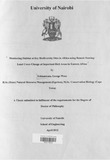| dc.description.abstract | Land cover change related to both anthropogenic activity and natural causes is taking place invariably at different time periods, paces and magnitudes and with diverse biophysical implications on the various land cover types as well as on biodiversity. This study investigated the percentage and extent of land cover change across all major land cover types at a subset of 71 Important Bird Areas in Eastern Africa over a 20-year period using remotely sensed data. At regional level, during the study period, broad land cover change trends show a dramatic decline in natural habitats such as forests, shrub lands, herbaceous and flooded vegetation.
The decline in natural land cover types and a concomitant increase in the percentage of modified and converted land cover types points to the fact that natural habitats were converted or modified into anthropogenic and intensively managed land cover and land uses types such as agriculture, plantation crops, natural agricultural mosaic and urban areas. Population density at the sites varied between 9 and 2,701 persons per sq.km with the latter associated with sites in proximity to urban centres. Population density around IBAs was not a significant correlate of extent and rates of land cover change within IBAs for all land cover types except that it slightly contributed to change in shrub land.
Outside IBAs, population density was, as was expected, the most significant factor driving urban expansion, probably manifested by the conversion of natural habitats to urban landscape. Agriculture was the most significant correlate of land cover change driving the observed changes in all forests, open forest/woodlands, shrub lands and herbaceous/grasslands. It was not significant for the rest of the land cover types. Regarding land cover change outside IBAs, agricultural extent was the most significant factor in naturalagricultural mosaic, herbaceous/grassland and urban land cover changes. The impact of legal protection and site specific past conservation interventions was assessed.
Protection was not a significant factor in reducing land cover type apart from open forest/woodland habitats. Working with Site Support Groups (SSGs) to implement site specific conservation interventions did not translate into reduced land cover change at IBAs across all land cover types apart from shrub land. However, whether this could be attributed to the smaller sample size of the SSGs used in this study and the shorter period some of the SSGs have been in existence requires further assessment with larger sample sites with a longer history of engagement. All forests and grasslands IBAs were identified as the key biodiversity sites most vulnerable to increased rates of deleterious land cover change as a result of agricultural expansion and intensification and human population density.
It is recommended that urgent measures be put in place to improve effective management of protected areas to increase their ability to conserve biodiversity. Efforts should also be expended towards preventing deleterious land cover change outside key biodiversity sites through sustainable land use systems and environmental friendly development initiatives. This will reduce the effects of fragmentation and edge effects and promote the conservation of biodiversity within the surrounding agricultural and human dominated and modified landscapes. This study represents a prototype technique that can be applied to IBAs elsewhere. | en_US |

